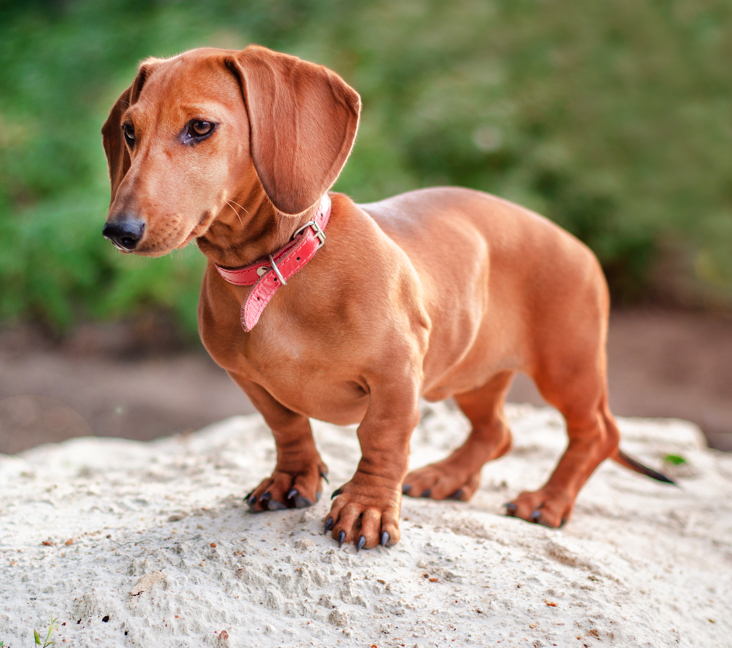Have you ever thought about “when do dachshunds stop growing?” Knowing this can assist you in giving them the best care. In this detailed guide, we will discuss the usual timeframe for dachshunds to reach their maximum size, the phases of their growth, and the elements that impact their development. By the conclusion, you will be aware of what to anticipate as your dachshund grows and how to promote their well-being.

When Do Dachshunds Stop Growing?
Typical Age Range for Reaching Full Growth
Dachshunds typically reach their mature size between 12 and 18 months of age, although this can depend on various factors. Some dachshunds may reach their full size as early as 10 months, while others may continue growing until they are 24 months old. Understanding when dachshunds finish growing can assist in properly addressing their dietary and exercise requirements.

Variations in Growth Patterns
Similar to humans, dachshunds have unique growth rates. Some may go through sudden growth spurts, while others grow steadily. Keeping track of your dog’s weight and size regularly can help you detect any abnormal growth patterns early, enabling you to promptly address any potential health concerns.
Dachshund Growth Stages
Puppyhood (0-6 Months)
Fast Growth Period
The initial six months of a dachshund’s life are characterized by rapid growth. During this period, they gain weight rapidly and increase in height every week. It is important to provide a well-rounded diet full of essential nutrients to aid in their growth.
Weight and Size Projections
During this phase, a standard dachshund puppy typically weighs between 4 to 11 pounds, while a miniature dachshund ranges from 2 to 5 pounds. Monitoring their weight regularly ensures they are developing at a proper pace and allows for adjustments to their diet if necessary.

Adolescence (6-12 Months)
Reduced Growth
Between six to twelve months old, your dachshund’s growth rate decreases. This phase focuses more on muscle and bone development rather than rapid physical changes. It is crucial to maintain a balanced diet and provide regular exercise during this period.
Changes in Size and Weight
In their adolescent stage, standard dachshunds typically weigh between 11 to 20 pounds, while miniature dachshunds range from 5 to 11 pounds. Even though their growth may not be as obvious, they are still maturing internally and require consistent attention.

Adulthood (12-18 Months)
Dachshunds usually reach their full adult size between 12 to 18 months old, with fully developed bones and reaching their genetic height and weight potential. It’s important to switch from puppy food to adult dog food at this stage for their overall health.
As adults, standard dachshunds generally weigh between 16 to 32 pounds, while miniatures weigh approximately 11 pounds or less. Keeping an eye on their weight is crucial to keep them healthy and prevent obesity and associated health problems.
Weight Expectations by Age
Average Weight at Different Growth Stages
Knowing the average weight expectations for different growth stages is important to ensure your dachshund is growing properly. Below are the weight milestones for standard and miniature dachshunds:
| Age Range | Standard Dachshund Weight | Miniature Dachshund Weight |
| 0-6 months | 4-11 pounds | 2-5 pounds |
| 6-12 months | 11-20 pounds | 5-11 pounds |
| 12-18 months | 16-32 pounds | Less than 11 pounds |
These guidelines can help you track your dachshund’s growth progress and make sure they are developing healthily. Specifically, knowing when do dachshunds stop growing will help tailor your care to their unique needs.
Comparison Between Standard and Miniature Dachshunds
Standard and miniature dachshunds have unique growth patterns and size expectations. Standard dachshunds tend to grow larger, reaching weights of 16-32 pounds by 18 months old. On the other hand, miniature dachshunds are smaller, typically weighing under 11 pounds as adults.
It is important to understand these differences in order to provide proper care and nutrition. Standard dachshunds may need more calories and exercise compared to miniatures, who require a diet and activity level suitable for their smaller stature. Knowing when do mini dachshunds stop growing– usually around 12 months old- can help adjust their diet and exercise routine to promote healthy development. Adapting your approach based on these growth patterns ensures that both standard and miniature dachshunds thrive.

Factors Influencing Growth
Genetics
Genetics play a crucial role in determining the growth timeline and size potential of dachshunds. The size of the parents and their breed lineage can significantly impact how big your dachshund will grow. For instance, if both parents are large, your dachshund is likely to also be larger. Conversely, if they come from a line of smaller dachshunds, they may remain petite. Understanding your dachshund’s genetic background can offer valuable insights into their growth patterns, helping you anticipate when do dachshunds stop growing and how to best support their development.

Diet and Nutrition
Providing a well-balanced diet is essential for the healthy development of your dachshund. It is important to offer a variety of proteins, fats, carbohydrates, vitamins, and minerals through high-quality dog food designed for their specific life stage. Selecting the best dog food for dachshunds guarantees they receive the necessary nutrients for proper growth and progress.
Both overfeeding and undernourishment can have negative effects on your dachshund’s development. Overfeeding may result in obesity, which can strain their long backs and joints, increasing the risk of intervertebral disc disease (IVDD). Conversely, malnutrition can hinder their growth and weaken their immune system. Monitoring your dog’s weight regularly and adjusting their diet accordingly is crucial for their health. Seeking advice from your veterinarian for personalized dietary recommendations can further ensure your dachshund stays healthy and flourishes throughout their life stages.

Exercise and Physical Activity
Regular physical activity is crucial for dachshunds to build muscle strength and stay healthy. Activities like daily walks, playing fetch, and supervised playtime are important for their fitness and well-being. It’s recommended to aim for at least 30 minutes of exercise every day to keep your dachshund active and mentally engaged.
It’s essential to be cautious when exercising dachshunds, as their long bodies make them prone to back issues. Avoiding activities that involve jumping or excessive running is key to preventing injuries and supporting their long-term health and mobility. By providing consistent and suitable exercise, you can ensure your dachshund remains happy, healthy, and energetic throughout their life.
Health Conditions
Regular visits to the veterinarian are important for keeping track of your dachshund’s growth and well-being. Your vet can offer advice on nutrition, exercise, and any health issues that may arise, ensuring your pet grows up in good health and with strength.

Signs That Your Dachshund Has Stopped Growing
Determining the point at which dachshunds reach their full size requires paying attention to both physical cues and shifts in behavior:…
Physical Indicators
- Adult Size and Weight: Your dachshund will reach their full adult size and weight, usually by about 18 months old. This signals the completion of their growth period.
- Stable Growth Pattern: After reaching adulthood, keep an eye on their size and weight to make sure they stay within a healthy range and maintain a consistent growth pattern.
Behavioral Changes
As dachshunds grow older, they may become less playful and more relaxed, displaying a decrease in puppy-like behavior. Their energy levels become more consistent, and they establish their adult temperament, signaling that they have entered adulthood. Recognizing these indications can assist you in determining when dachshunds reach their full size and supporting their smooth transition into adulthood while keeping them healthy and lively.

Veterinary Advice
Importance of Monitoring Growth
Keeping an eye on your dachshund’s growth is important to make sure they grow up healthy. Regular vet visits and keeping track of their weight can give you important information about their progress and help avoid possible health problems.
When to Consult a Vet for Growth Concerns
If you observe any abnormalities in the growth of your dachshund, it is important to seek guidance from a veterinarian. Any signs such as slow growth, too much weight gain, or unusual physical changes should be brought to the attention of a professional for proper intervention.
FAQs
Can diet affect when dachshunds stop growing?
The diet plays a significant role in determining when dachshunds reach their full growth potential. It is important to provide them with a well-balanced diet that meets their specific nutritional requirements for healthy development. Following a dachshund feeding chart can help ensure they get the necessary nutrients for proper bone and muscle growth. On the other hand, poor nutrition or overfeeding can result in issues like slowed growth or obesity, affecting their overall health and potentially delaying their growth progress. Keeping a close eye on their diet based on factors like age, weight, and activity level can help optimize their growth and promote long-term health and energy.
Do miniature dachshunds stop growing earlier than standard dachshunds?
Miniature dachshunds generally reach their full size sooner than standard dachshunds. Miniature dachshunds usually stop growing and reach their adult size by approximately 12 months old. On the other hand, standard dachshunds may continue to grow a bit longer, typically reaching their full adult size between 12 to 18 months. It is crucial to closely monitor their growth during these periods to promote healthy development and promptly address any possible health issues.
What are the signs of stunted growth in dachshunds?
Indications of stunted growth in dachshunds appear as clear deviations from the normal growth patterns for their age. These signs can include being noticeably smaller than expected, experiencing unusual changes in weight, and delays in reaching physical milestones like teething or fur growth. It’s important to closely monitor these signs as they could point to underlying health problems or deficiencies in nutrition. Seeking advice from your vet promptly when you notice these signs is crucial to ensure your dachshund gets the right care and help to promote their healthy growth and development throughout their life. Recognizing these signs is key to determining when dachshunds reach their full growth potential.
Conclusion
Knowing when dachshunds stop growing and being able to identify the different phases of their growth is very important for giving them proper care. Their genetic makeup, as well as their diet and exercise routine, play a big role in how they develop. It’s crucial to keep a close eye on their progress and consult with a vet regularly to make sure your dachshund is healthy and growing well.
If you have any questions or want to share your own dachshund’s growth journey, feel free to join the discussion in the comments below!

